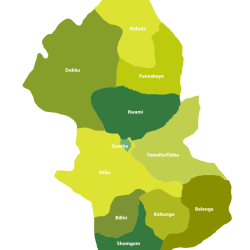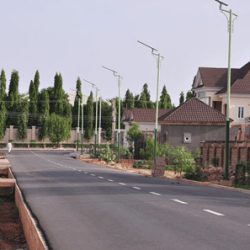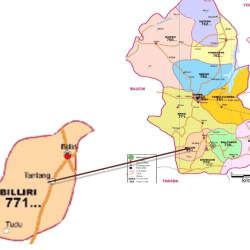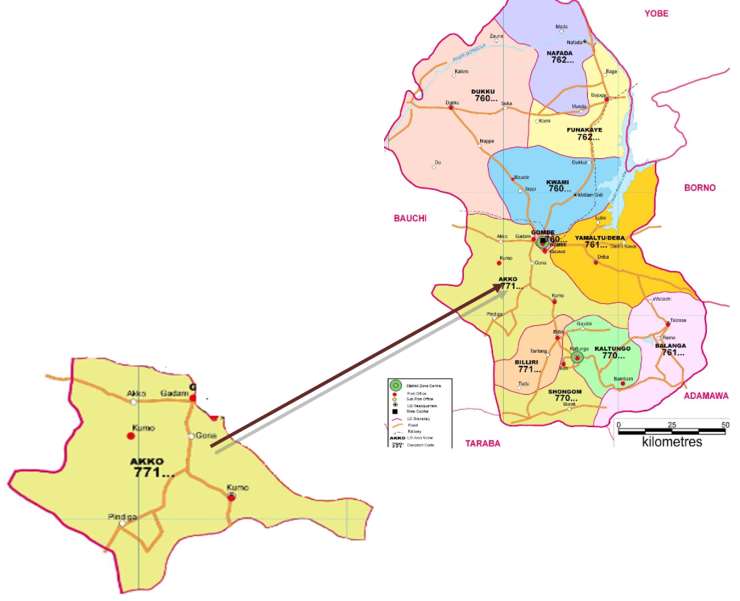The Tangale people are one of the ethnic groups in Northern Nigeria, situated in Gombe State. The Tangale people that majorly speak Tangale got their name from “Tangal”, a chief of Billiri, in the present day Gombe state of Nigeria. It is believed that Tangal was instrumental in organizing the clans under his leadership and because of this, the people under him were referred to as the Tangale (as it was customary in many African communities to name a land or ethnic group after their leader).
The seven clans that make up the Tangale chiefdom are Tangaltong, Tal, Kalmai, Todi, Banganje, Nathe and Billiri, which is seen as the most important of all the clans.
One of the main contending issues that is widespread among Nigerian Societies these days, is that besides the generally acknowledged pre-colonial entities like the Sokoto Caliphate, Oyo, Benin and Kanem-Borno Empires to mention a few is that there were also other isolated ethnic groups which had existed in their own sovereign kingdoms, City States, Chiefdoms and large Confederations under their own traditional rulers. The Tangale Chiefdom/Kingdom belong to one of these sovereign political entities. The Chief of Tangale (Mai Tangale or Mai Yelli) had before the advent of the British Colonial rule in Nigeria effectively used the old brigade of Palace countiers and traditional elite groups in the course of performing his political, administrative and religious leadership of an independent and well defined geographical boundary known as Tangale Kingdom or Chiefdom.
By the same token the paramount ruler of Tangale in pre-colonial time had occupied the role of the Head of State and Commander-In Chief of the Tangale nation. At the inititial stage the surbodinate Chiefs of Tal (Mai Bekeri) and Kanthilang (Mai Kanthilang) also from Billiri in Tangaltong were considered higher in hierarchy than the other surbordinate Chiefs that sat next to the Chief of Tangale and Chairman of the pre-colonial Tangale Traditional Council. The other lesser Chiefs (Ana-Mai-Mana) that emerged later included: Mai Kalamai (which replaced the hierarchical position of Mai Kanthilang following the migration of Kanthilang to Kalmai); Mai Banganje; Mai Tanglang; and Mai Todi.
The office of the Chief of Tangle (Mai Tangle or Mai Yelli) under the pre-colonial Traditional form served as the engineering machinery for the exercise of political control and leadership functions over the affairs of the entire Kingdom or Chiefdom.
Highlights of the salient functions of the Chief of Tangale then were:
Presiding over the meetings of the Tangale Council of State (PONAR COUNCIL) and other councils such as Kwi-Pand-Ana-Mai, Kawaddiyo, Pobune and Ladum/Malgwagam.

Other important functions that were performed solely by the Chief of Tangale included: PODUK MUTHO, a traditional religious duty intended to remove or cast away all sorts of epidemic among the Tangale people; ANGU SHIRA, payment of compensation for the release of slave or payment in exchange for possible retaliatory action by relations of a murdered person; WUL-ID-SAU, contracting a compulsory marriage between a husband and wife. Such kind of marriage wasmeant for life, thus its termination through divorce was unthinkable.
Also, it was the duty of the Chief of Tangale to administer either oath or solemn affirmation in cases that involved settlement of land disputes among the Tangale people. As is the practice in mother organisations, the office of the chief of Tangale in the pre-colonial time discreetly applied the principles of delegation of powers to enhance the effective and efficient administration of Tangale Kingdom or Chiefdom.

Tangale Chiefdom in pre-colonial time had five (5) traditional institutional Councils through which the management of both political and judicial affairs of the land were carried out. They included: Ponar; kwi-Pand-Ana-Mai; Kwaddiyo; Pobune; and Ladum/Malkwagam.
EXISTING TRIBES FOUND IN TANGALE CHIEFDOM
Tangale Chiefdom in pre-colonial time was predominantly occupied by the seven major clans of the Tangale nation. However, following the establishment of the British Colonial rule in Tangale Waja Region in the early 20th Century, other ethnic nationalities started migrating into the Land.
For instance, one of the British District Officers who served in Gombe Division had in his Handing Over Notes in early 1934 that, ‘’Of the three Districts it seems certain that only West Tangale is organised administratively on lines which nearly accord with local traditional custom and sanction. All the inhabitants, with the exception of some 450 Wurkunawa and a few Hausa traders and Fulani herdsmen are Tangales and they all regard Sarkin Biliri as their hereditary Chief’’
Earlier in February, 1934, the British Assistant District Officer in charge of Tangale-Waja District wrote the District Officer of Gombe Division and explained the position of the Chief of Tangale before the British advent as follows, ‘’This District is inhabited by approximately 16,550 West Tangales, 450 Wurkunawa, 250 Jukunawa and 250 of mixed origin (Hausa, Fulani etc).
The Traditional form of government before the British advent was by a Chief, who was considered ruler of the whole West Tangale Village Heads. Moreover, the Chiefdom of the entire tribe was invariably held by the Village Head of Billiri, this being the most important Village in point of precedence. Traditionally, the Chief of West Tangale appears to have been an autocrat. The present form of government in West Tangale District, therefore, may be considered not to have diverged, in essentials, from its original parent.
The present District Chief is a direct descendant of a long line of Chiefs of West Tangale’’. In this 21st century, Tangale Chiefdom, especially Billiri town its capital as well as that of the Local Government has astronomically assumed a cosmopolitan nature, thus reflecting the presence of almost all the ethnic nationalities of the defunct Tangale Waja Native Authority, other nationalities from the North East Region and quite a number of others from the rest of the North and South of Nigeria.
Sample of the ethnic nationalities from the defunct Tangale Waja Native Authority presently residing permanently in Tangale Chiefdom include: Waja, Lunguda, Cham, Tula, Dadiya, Kosshi, Bangunji, Pero-Shonge, Kamu, Awak and the Jukun etc.
Other nationalities from the rest of the North East Region included: Tera, Bolawa, Babur-Bura, Kanakuri, Bachama, Kanuri, Shuwa-Arabs, Kare-Kare, Ngism, Ngamo, Chamba, Mumuye, Jukun, Fulani and so on.
Other ethnic nationalities from the rest of the North and South of Nigeria residing in the Chiefdom include those on national assignments in Federal Agencies and those that voluntarily migrated on personal grounds. The above group comprise: Jarawa, Sayawa, Bajju, Kaje, Birom, Ebira, Idoma, Igala, Tiv, Bassange, Hausa, Fulani, Igbo, Yoruba, Ijaw, Itsekiri, Urhobo, Ibibio etc.
ORIGIN OF TANGALE PEOPLE
The issue of accuracy which ought to have been the main feature for writing the history of Tangale people is very difficult to attain for now. This is principally because the archeological research break-through in this area is still progressing and our account is tentative information that tends to be isolated in space and time, but gives a more coherent picture of Tangale Chiefdom and its main occupants.
The Tangale people have been ranked among the first twenty-one (21) major ethnic groups and languages in Nigeria.
The exact date of migration of the people of Tangale Chiefdom to their present location is yet unknown. Be that as it may, the Tangale people believe that they came from Yemen in the far East.
Perhaps, one would suggest that their migration into the country was as a result of the general movements that affected most of the North African Societies and their middle-Eastern neighbors which occurred sometimes between the 17th and 11th centuries.
However, earlier writings on the Tangale people suggest that their migration from the Far East through Ngazargamu in Kanem-Bornu Empire into the initial boundary of Tangale Chiefdom might have taken place between the 13th and 15th Centuries. The Jukun nation of kwararrafa Kingdom had also acknowledged that they had contact and cordial relationship with the Tangale nations as far back as 1350A.D.
Mr. J.J Carlyle, one of the British Colonial Officers that wrote a brief account of the history of Tangale nation referred to them as being the first ethnic group to have occupied Gombe Emirate long before the emergence of the Sokoto Caliphate in 1804. The Bolawa people concurred with the account given by Mr . J.J Carlyle in his brief history of the Tangale ethnic group. Also, Mr . F.S.V. Wiesbaden, a german researcher in his handbook of ethnic Units in Nigeria {1985), acknowledged that “the Tangale were the earliest dominants of what is now Gombe Emirate”
From time immemorial, the Tangale nation had comprised major clans (Tul Tangle Pelou) namely:
Tangaltong (Biliri and Bare); Tal: Kalmai; Banganje ; Tanglang; Todi and Nathe.
PRESENT LOCATION OF TANGALE CHIEFDOM
Following the earlier relocation and/or annexation of its parts to both Akko and Alkaleri Local Governments by the British Colonial and post independent administrations, Tangale Chiefdom is presently located mainly within Billiri Local Government Area/Council of Gombe State.
The Chiefdom is situated in the present Gombe State of Nigeria. It lies South of Akko Emirate, between longitude 10° and 12° West and Latitude 9° and 10° North. The land covers an approximate area of seven hundred and fifty square kilometers. The major towns and villages in Tangale Kingdom/Chiefdom include Biliri (also known as Lawisshi Biliri), the Headquarters of the Chiefdom and the present Billiri Local Government Council; Tal; Kalmai; Banganje; Tanglang; Todi and Kwaya.
Other notable village settlements in the Chiefdom include: Biliri Kufai (Kumana); Komta; Pokwangli; Sikkirit; Lasale; Belfebe (Sansani); Kalindi; Lakwene; Lawisshi-Lapandi (Lawisshi Daji); Pissi-Ukko; Pagla; Laker; Polido; Lawilthew; Ladongor; Amtawalam; Pobawure; Lawur-Kondo; Lamughu; Kulkul; Ayaba; Kolok-Kwannin; Pandinkude; Kurum; Sabon Layi (Popandi); Lakwanthiling (Lalai Pitho); Dombe; Layer; Shela; Kwi-Bwa; Tangji; La-kwalak; Panguru Lakelembu, Latoddo, Lakalkal, Bassa, Lasant Lawampe, Ayansari etc.
DISTRICTS IN TANGALE CHIEFDOM
In pre-colonial time, Tangale Chiefdom had seven (7) operational Districts under
the leadership of Mai Biliri, who was the paramount ruler as the Chief of Tangale (Mai Tangle or Mai Yelli). After the establishment of the British Colonial administration in the Chiefdom and the entire Tangale Waja Region, the position of District Heads were reduced to the position of Village Heads, while the paramount ruler though retained his position as the over all traditional ruler in the land, but paradoxically had his nomenclature reduced to a District Head. Subsequent developments during the British colonial administration brought about Kwaya as the eighth Village Administrative Area in the Chiefdom.
However, with the coming of the first Civilian administration in Gombe State, Tangale Chiefdom did not only witness the re introduction of its Districts that existed in pre-colonial time, but was also overwhelmed with the astronomical increase in the number of the new Districts to eighteen (18).
The second Civilian administration on assumption of duty in the State decided to reduce the eighteen (18) Districts to only eight initially, but later added one thus giving a total of nine (9) presently.
The nine (9) operational Districts in Tangale Chiefdom presently are as follows:
- Biliri District
- Ladongor District
- Tal District
- Kalmai District
- Bare District
- Banganje District
- Todi District
- Tanglang District
- Kwaya District
PERMANENT MEMBERS
- Wakilin Wazirin Tangale
- Shetiman Tangale
PART TIME MEMBERS
- Wazirin Tangale
- Ajiyan Tangale
- Matawallen Tangale
- Sarkin Zangon Tangale
- Rep. Muslim Community
- Rep. Christian Community
- Chairman Billiri Local Government Council
- Secretary Tangale Traditional Council
KING MAKERS
WAZIRIN TANGALE OR WAKILIN WAZIRIN TANGALE
All the Nine (9) District Head
- Billiri District Head
- Ladongor District Head
- Tai Distirct Head
- Kalmai District Head
- Bare District Head
- Banganje District Head
- Todi District Head
- Tanglang District Head
- Kwaya District Head
THE VILLAGE AREAS IN TANGALE CHIEFDOM
Presently, there are twenty four (24) village Areas in Tangale Chiefdom. The Village Areas are as follows:
BILLIRI DISTRICT
Poshiya Village Area
Shembe Village Area
Awai Village Are
LADONGOR DISTRICT
Pokwangli Village Area
Ladongor Mana Village Area
Lawilthu Village Area
Belfebe (Sansani) Village Area
TAL DISTRICT
Bekeri Village Area
Pandinkude Village Area
Pandikuduk (Ayaba) Village Area
KALMAI DISTRICT
Kalmai Mana Village Area
Pabawure Village Area
BARE DISTRICT
Kentengereng Village Area
Komta Village Area
Lawisshi Lapandi (Daji) Village Area
BANGANJE DISTRICT
Baganje Mana Village Are a
Lareka Village Area
Popandi (Saban- Layi) Village Area
TODI DISTRICT
(Todi) Pandipino Village Area
Sukan-Sukan (Shela) Village Area
TANGLANG DISTRICT
Tanglang (Kubat-Kungu) Village Area
Kulkul Village Area
KWAYA DISTRICT
Tudun Gari Village Area
Kwaya Village Area
THE TANGALE MAI DOM OF GOMBE STATE
MAI BURIAL PERIOD
Kiu Ca. Late 13th Century Kummana (Uphill)
Tangal Ca. Late 14th Century Kummana (Uphill)
Somboro Ca. 15th Cent.- early 16th Cent. Kummana (Uphill)
Akwai Ca. Late 16th – early 17th Cent. Kummana (Uphill)
Asonong Ca. Late 17th – 18th Century Kummana (Uphill)
Wuni Ca. Late 18th Century Kummana (Uphill)
Mela Ca. Late 18th – early 19th Cent. Kummana (Uphill)
Dula Ca. Late 19th Century Kummana (Uphill)
Sheru I Ca. Late 19th Century Kummana (Uphill)
Bilam Late 19th Century Kummana (Uphill)
Wana Late 19th Century Kummana (Uphill)
Mai Yamba CBE 1915-1951 Poshiya
Iliyasu 1951-1986 Poshiya
Muhammadu 1986 – 1997 Poshiya
Abdu B. Maisheru II OON 2001 –







